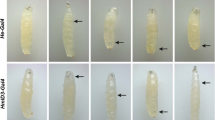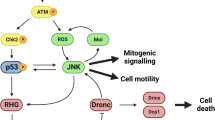Abstract
THE homoeotic mutants of Drosophila are of special interest in developmental biology because they cause the substitution of one body segment by another in the adult. The antennae of tumorous head (tuh) flies are replaced by mesothoracic leg tissue and part of the head by genital structures1,2 (Fig. 1). Homoeotic mutants are thought to be the result of mutations in regulatory genes3 which cause a suppression of the activity of one set of genes and the activation of an alternative set to bring about such a specific, well-defined transformation. These mutations somehow cause a group of cells at some stage in the life cycle to change their developmental pathway and differentiate during metamorphosis into different structures from those which they would normally form. We have analysed the tumorous head mutant and report here that it is probably the consequence of a gene acting at the time of determination.
This is a preview of subscription content, access via your institution
Access options
Subscribe to this journal
Receive 51 print issues and online access
$199.00 per year
only $3.90 per issue
Buy this article
- Purchase on Springer Link
- Instant access to full article PDF
Prices may be subject to local taxes which are calculated during checkout
Similar content being viewed by others
References
Postlethwait, J. H., Bryant, P. J. & Schubiger, G. Devl Biol. 29, 337–343 (1972).
Bournias-Vardiabasis, N. & Bownes, M. J. Embryol exp. Morph. 44, 227–241 (1978).
Morata, G. & Lawrence, P. A. Nature 265, 211–214 (1977).
Lewis, E. B. Am. Zool. 3, 33–56 (1963).
Morata, G. & Garcia-Bellido, A. Wilhelm Roux's Archiv. 179, 125–143 (1976).
Morata, G. J. Embryol exp. Morph. 34, 19–31 (1975).
Rice, T. B. & Garen, A. Devl Biol. 43, 277–286 (1975).
Zalokar, M. Proc. natn. Acad. Sci. U.S.A. 68, 1539–1541 (1971).
Gehring, W. J. in Insect Development (ed. Lawrence, P. A.) (Blackwell, Oxford, 1976).
Illmensee, K. in Insect Development (ed. Lawrence, P. A.) (Blackwell, Oxford, 1976).
Chan, L. N. & Gehring, W. Proc. natn. Acad. Sci. U.S.A. 68, 2217–2221 (1971).
Gardner, E. J. Adv. Genet. 15, 116–146 (1970).
Kuhn, D. T. Evolution 24, 181–187 (1970).
Suzuki, D. J. Science 170, 695–706 (1970).
Ouweneel, W. J. Adv. Genet. 18, 179–248 (1976).
Nöthiger, R. in Biology of Imaginal Discs (eds. Urspring, H. & Nöthiger, R.) 1–28 (Springer, Berlin, 1972).
Garcia-Bellido, A. Am. Zool. 17, 613–631 (1977).
Garcia-Bellido, A. & Santamaria, P. Genetics 72, 87–107 (1972).
Shearn, A., Rice, T., Garen, A. & Gehring, W. Proc. natn. Acad. Sci. U.S.A. 2594–2598 (1971).
Ephrussi, B. & Beadle, G. W. Am. Nat. 70, 218–225 (1972).
Baker, W. Genetics 88, 743–754 (1978).
Author information
Authors and Affiliations
Rights and permissions
About this article
Cite this article
BOURNIAS-VARDIABASIS, N., BOWNES, M. Tumorous head is a maternal-effect homoeotic mutant of Drosophila melanogaster. Nature 276, 611–612 (1978). https://doi.org/10.1038/276611a0
Received:
Accepted:
Issue Date:
DOI: https://doi.org/10.1038/276611a0
This article is cited by
-
Characterisation of a new tumorous-head mutant of Drosophila melanogaster
Molecular and General Genetics MGG (1981)
-
Genetic variability of the tumorous-head maternal effect in Drosophila melanogaster
Molecular and General Genetics MGG (1980)
Comments
By submitting a comment you agree to abide by our Terms and Community Guidelines. If you find something abusive or that does not comply with our terms or guidelines please flag it as inappropriate.



